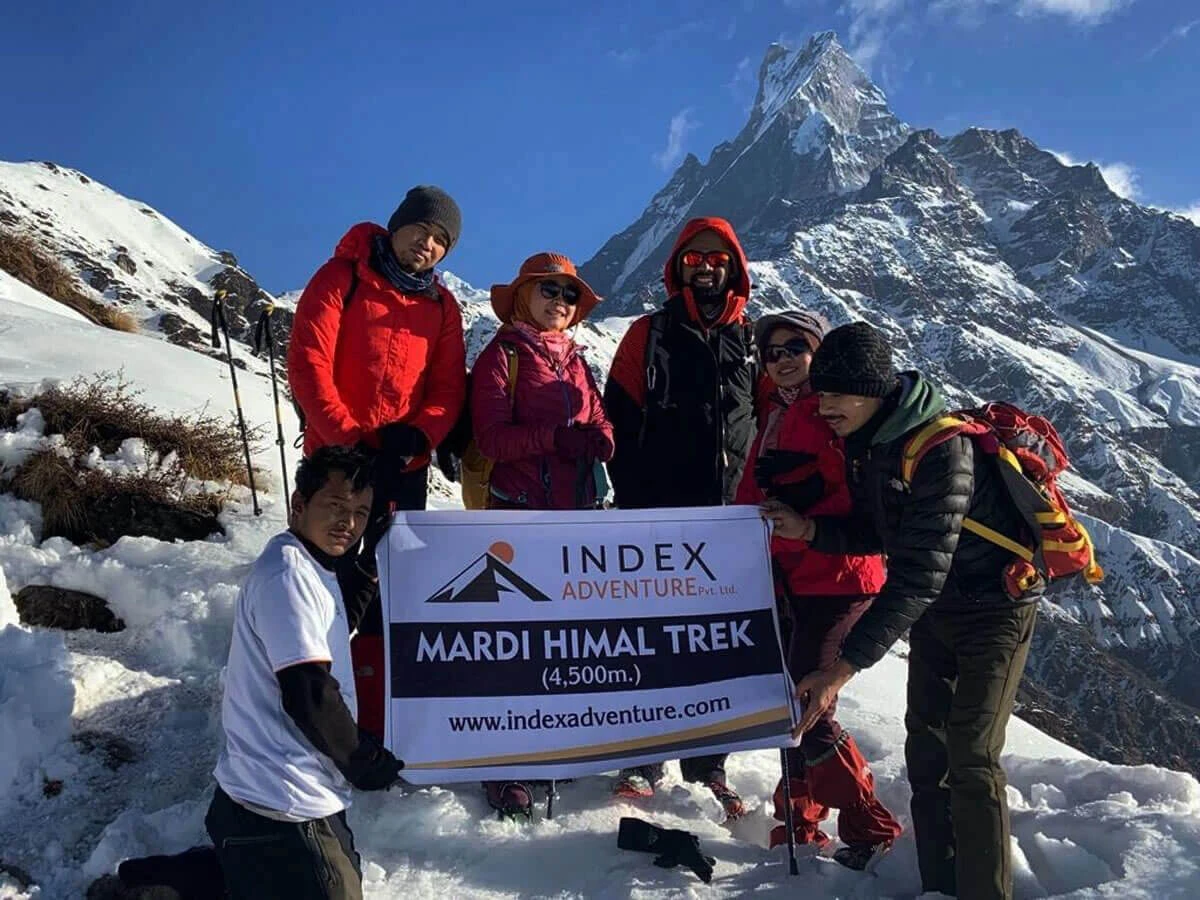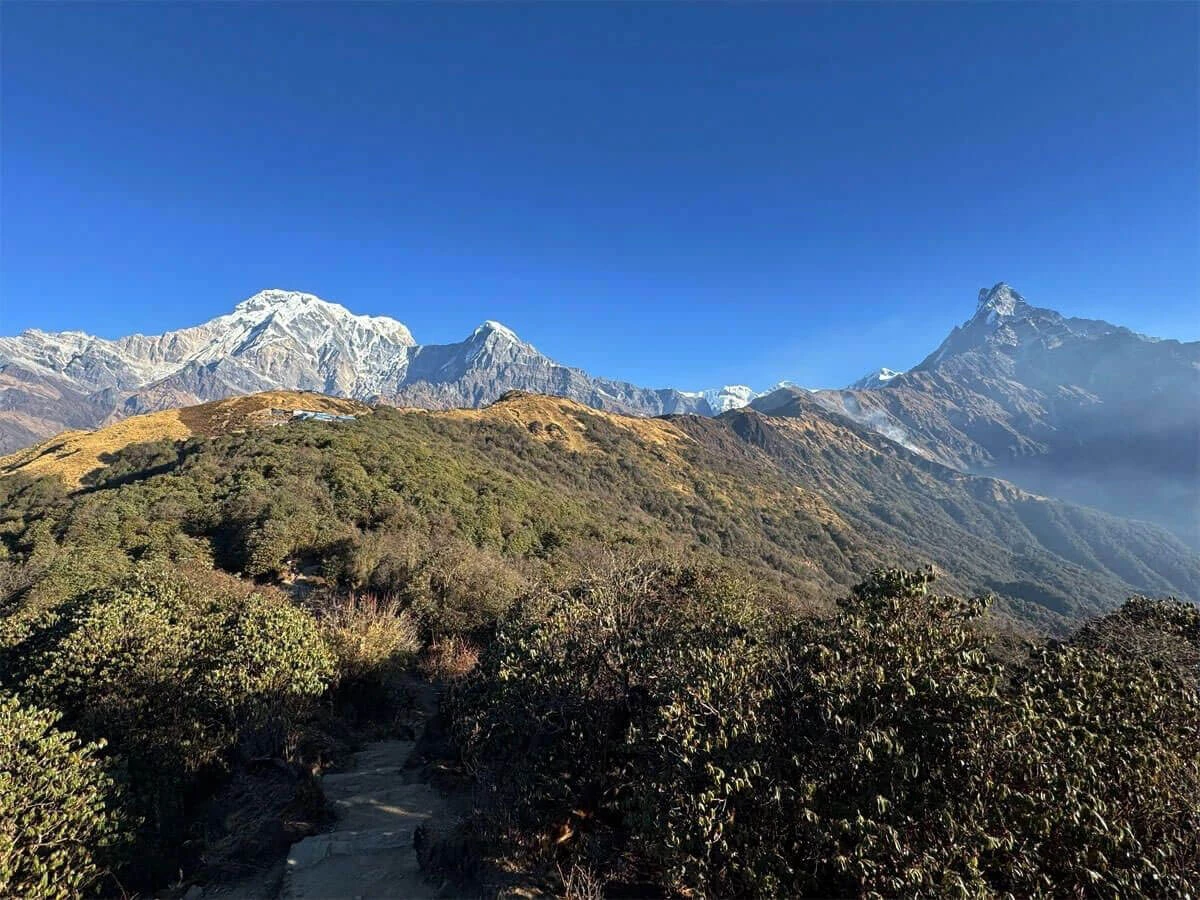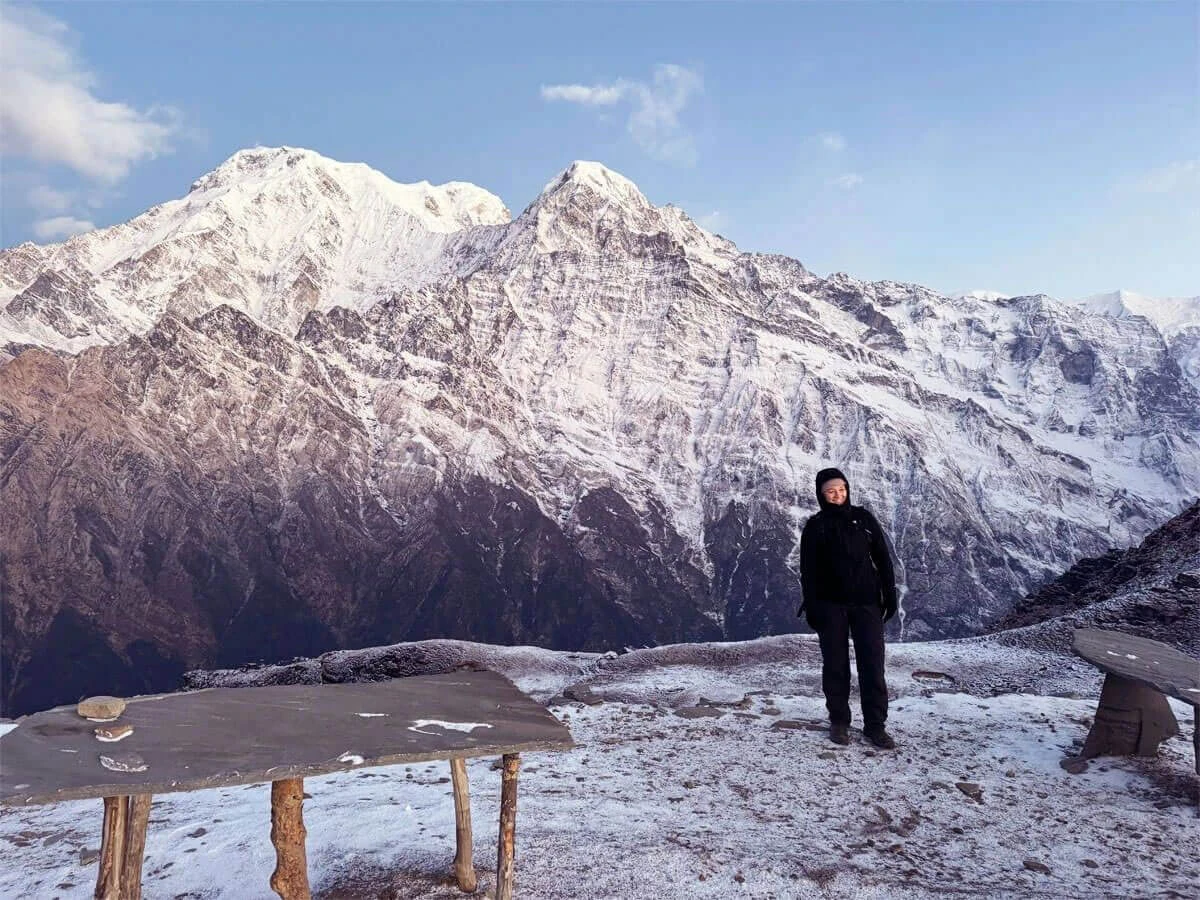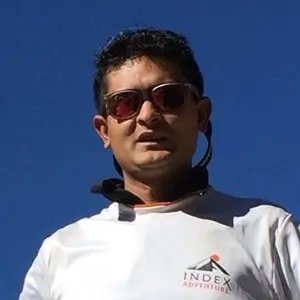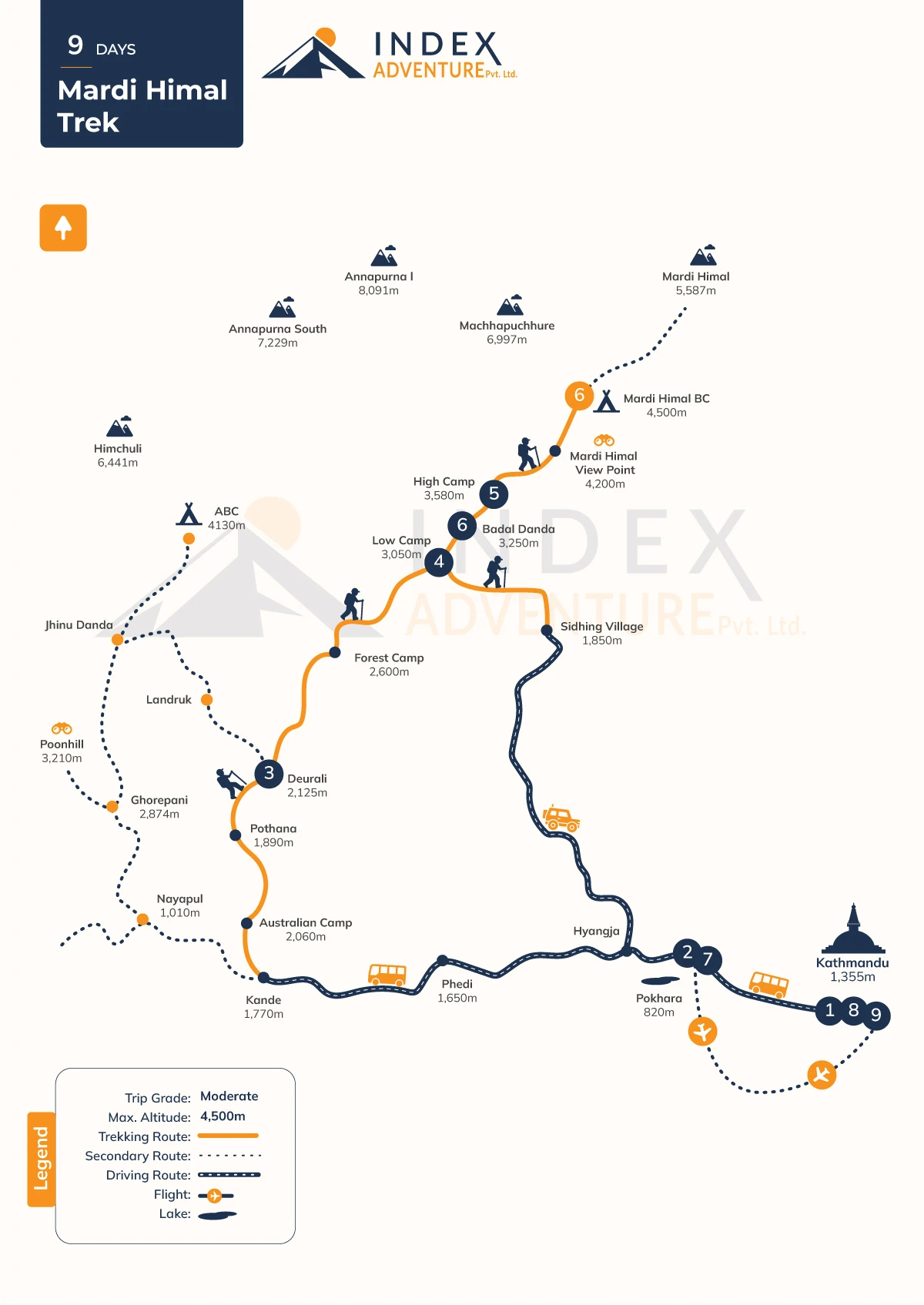The Mardi Himal trek is a short journey into the heart of the Annapurna. This leisurely hike, suitable for trekkers of all expertise, takes you to the less-crowded regions, allowing you to have a serene experience with nature.
The 9-day Mardi Himal trek takes you across various terrains and settlements. From the steep rhododendron forests to the rugged alpine terrain, each section is equally beautiful. Additionally, the occasional views of Huinchuli (6441 meters), Dhaulagiri (8163 meters), Machhapuchre (6991 meters), Annapurna (8091 meters), and Mardi Himal (5588 meters) further make.
Your trek begins in Pokhara, where you will board a bus to Kande. The scenic drive follows the Seti River along the winding highway. From Kande, you will hike a short distance, passing local settlements and Australian Camp, to Deurali. From Deurali, you will continue to Low Camp and the dense forests of Forest Camp.
From Forest Camp, you will enter the alpine terrain as you head toward High Camp before finally ascending to Mardi Himal Base Camp. Enjoy the mesmerizing panoramic views of the Himalayas and find Machhapuchhre, standing tall, before beginning your descent to Pokhara.
The one-week Mardi Himal Trek is a perfect escape into the peaceful Himalayas. Suitable for people on a time crunch, this trek is fully customizable. For the trip of a lifetime, book your Mardi Himal Trekking adventures now!
Major Highlights of the Mardi Himal Trek
- Stunning Himalayan views, including Annapurna, Machhapuchhre, Hiunchuli, and Mardi Himal
- Journey into the off-the-beaten-path trails away from the more conventional touristy crowd of Poon Hill and Annapurna Base Camp
- Walk through lush rhododendron, oak, and pine forests
- Comfortable accommodations and warm hospitality at cozy teahouse lodges
- Incredible sunrise view from Mardi Base Camp
- Close-up view of Machhapuchhre
- Short yet rewarding journey ideal for both beginners and expert trekkers
Why Go on the Mardi Himal Trek?
The Mardi Himal trek blends cultural and Himalayan adventures on a single journey. Furthermore, this Annapurna region trek is suitable for both beginners and experienced trekkers and is gaining popularity. Here are the top reasons to go on the Mardi Himal Trek.
Serene Trekking Adventure: Unlike the busy Annapurna Base Camp trek, the Mardi Himal trek is a rather peaceful experience in the lap of the mighty mountains. You trail along lush rhododendron and bamboo forests, embracing the tranquility around you. The trek gives you a one-on-one experience with nature, allowing you to immerse yourself in its magnificent aura.
Cultural Experience: The 9-day Mardi Himal Base Camp trek takes you from one village to another. You to experience the rich and unique Himalayan cultures. Home to Gurung, Magar, and Brahmin communities, the cultural diversity of the region enhances the trekking experience.
Magnificent Mountain Views: As you journey along the trails to Mardi Himal Base Camp, you get impressive views of mighty mountain peaks, including South Annapurna, Machhapuchhre, Hiunchuli, Mardi Himal, and other surrounding peaks. Furthermore, the early morning and late afternoon treks provide spectacular views with mountains reflecting the golden hues during sunrise and sunset.
Suitable for All: Mardi Himal Trekking is a perfect trek for all travelers. This short-duration journey is easy and can be completed by people with basic fitness and stamina, unlike most treks in the Himalayas. Also, several rest stops along the way allow you to rest as you travel its diverse terrain.
How Difficult is the Mardi Himal Trek?
Compared to most high-altitude treks, the Mardi Himal is an easy journey in the Annapurna region of Nepal. Since this trek does not include technical trails, trekkers with a good level of fitness can easily complete the 9-day journey.
The trek ascends lush rhododendron forests, takes you to charming traditional villages, and tests your endurance during the alpine ascents before reaching the Mardi Himal Base Camp. While most sections are easy, you will tackle the steep uphill climb toward the Mardi Himal Base Camp before dawn, which is still achievable.
The trek takes you to a maximum elevation of 4500 meters. This altitude can cause mild symptoms of altitude sickness, but taking on the ascent gradually will help you acclimatize.
Preparing for the Mardi Himal Trek
The Mardi Himal Trek is an easy hike. You will travel the offbeat trails in the Annapurna region in Nepal as you enjoy the peaceful aura trails of this trek. Though easy, preparations are crucial to ensure a smooth and enjoyable trekking experience. The trek takes you through a diverse terrain ranging from lush forests to alpine meadows and narrow ridges. Careful planning of the physical readiness and equipment helps to eliminate all hassles during the one-week Mardi Himal Trek.
Training for stamina and endurance helps overcome the steep ascents and altitude gains, especially while approaching the Mardi Himal Base Camp. Likewise, you need to consider the weather conditions and prepare accordingly. The weather can vary significantly. The lower-altitude regions remain warm in spring and autumn, while it can be chilly at higher elevations.
Best Time for Mardi Himal Trek in 2025 and 2026
The Mardi Himal Trek best time is in spring, from March to June. The weather is pleasant, with wildflowers and rhododendron blossoms taking over the lush vegetation in the lower-altitude region. Additionally, there are fewer chances of rainfall, making it ideal for trekking, but watch out for the occasional afternoon showers. The skies are mostly clear, giving beautiful views of the icy peaks.
Like spring, the autumn months from September to December are equally suitable for trekking. There are chances of rainfall during the early months, but other than that, the weather is mostly clear, giving crisp views of the mountains. Compared to other months, autumn may see more footfall, but the trails are still peaceful compared to the more frequented Annapurna Base Camp trekking routes.
Winter, from January to February, can be cold. The snow-laden landscape makes navigation difficult. If you want to trek Mardi Himal in winter, take the necessary precautions. Also, as the conditions can be tough, the trek is advisable only for expert trekkers. However, with the recent change in weather patterns, you may find occasional crystal clear views of the landscape and the icy peaks.
The monsoon months from July to August pose a significant risk to trekkers. Heavy rainfall can cause floods and landslides, causing disturbances on the major highways. Even if you make it to the mountains, the slippery trails increase the risk of accidents and injuries. Due to these hazardous conditions, trekking to Mardi Himal during the monsoon season is not advisable.
Due to global warming, the Himalayas are experiencing unexpected weather changes. We encourage checking the weather before planning your Mardi Himal trek. Or, you can consult with our expert representatives at Index Adventure.
Mardi Himal Trek Permits 2025 and 2026
Travellers need to obtain the following permits before beginning the journey.
Permits for the Annapurna Conservation Area Project (ACAP): Mardi Himal is located in the ACAP region. You will need an ACAP permit to complete this trek. The ACAP Permit is available at the National Trust for Nature Conservation (NTNC) office in Kathmandu or Pokhara.
Trekkers' Information Management System (TIMS) Card: The TIMS card is a mandatory permit for Mardi Himal Trekking. You can get the TIMS card at the Nepal Tourism Board Office in Kathmandu or Pokhara.
Avoid the hassle of queuing for your permits. Book your Mardi Himal Trek with Index Adventure, and we will handle the permit arrangements in advance.
Contact us for Mardi Himal Trekking permit costs for 2025 and 2026.
Mardi Himal Trek 9-Day: Costs for Transportation, Guides, and Porters
The Mardi Himal trek 9-day cost depends on various factors. Your group size, number of trekking days, level of luxury, and additional services add up to the final cost. For a general idea of standard trekking prices, refer to our Mardi Himal Trekking fixed departure rates.
Our standard package comes with two-way road transportation (to and from Kathmandu), all necessary government permits, a guide for easy navigation, and a porter (one porter for two trekkers).
If you require additional services to comply with your needs, you can request a customized Mardi Himal trek package.
Mardi Himal Trek: Alternative Trekking Trails in Nepal
The one-week Mardi Himal trek is an easy trek suitable for all. From beginners to expert trekkers, this trail has something for everyone. The trail consists of serene jungle walks to the more adventurous narrow alpine ridges and Himalayan terrain explorations. Above all, trekkers can complete this adventure in just 7 days, and combine nearby destinations to make the trek more immersive.
Ghorepani Poon Hill and Mardi Himal Trek: If you have an additional day in hand, you can go on the 8-day Ghorepani Poon Hill and Mardi Himal Trek. This trek combines the touristy routes leading to Poon Hill, giving you stunning sunrise views before continuing the toward the secluded Mardi Himal trek.
Annapurna Base Camp Trek: The Annapurna Base Camp trek is a moderate journey that takes you to the foot of the mighty Annapurna. Like the Mardi Himal trek, the ABC trek suits both beginners and experts. However, the Annapurna Base Camp trek takes you to a busier route on an 8-day journey. Here, you can experience the diverse terrains of the region, passing through several local settlements.
Manaslu Circuit Trek: On the 15-day Manaslu Circuit Trek, you go on an adventure around the beautiful Manaslu Himal. You can enjoy views of several mountains, including Ganesh Himal, the Manaslu Himalayan Range, Manaslu, and other surrounding peaks. However, we recommend this trek for more experienced trekkers. Places like Larkye La Pass and other uphill climbs can be tough. But, with enough preparation, the 12-day Manaslu trek is possible for beginners with good physical strength, endurance, and stamina.
Index Adventure organizes treks across Nepal, offering unforgettable journeys into the Himalayas. Contact us to plan a safe and memorable adventure tailored to your needs.
Mardi Himal Trekking: Gear and Essentials Checklist
Before heading out into the Himalayas, ensure that you have packed your gear and essentials to ensure a safe and comfortable Mardi Himal trek.
- Trekking boots: Sturdy and waterproof boots with good ankle support
- Clothing: Base layer (thermal top and bottom), fleece jacket, down jacket, waterproof pants, trekking pants, woolen socks
- Backpack
- Sleeping bag: Warm sleeping bag rated for 0°C to -10°C, especially for winter treks
- Headlamps and flashlights: For the Mardi Himal Base Camp ascent
- Sun protection: Sunglasses, sunscreen, and lip balm
- Water bottle and purification tablets
- Trekking poles
- Personal medication and altitude sickness tablets
- Energy bars, nuts, and chocolates
- First aid kit
Customized Mardi Himal Trek
Trek the Mardi Himal according to your preferences. Index Adventure provides tailor-made Mardi Himal Trek packages. We offer personalized experiences by adjusting the itinerary, pace, and luxury based on your preferences.
Our customized Mardi Himal Trek packages allow you to extend your trek time, choose a quicker route, add side trips, choose specific trek dates, or request specialized services like private guides and porters.
Create a perfect adventure with a fully tailor-made trek offering a more relaxed and comfortable Himalayan experience. For a customized Mardi Himal Trek, consult with our expert guides.
